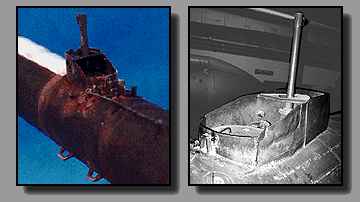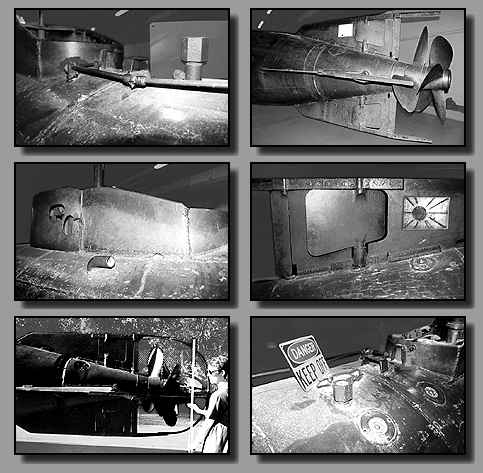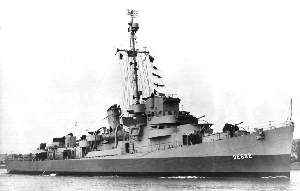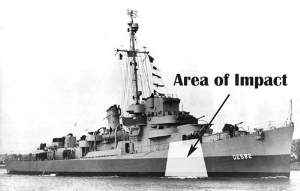

By late 1944, the war situation had deteriorated for Japan to the point where extraordinary measures were seen as offering the only way out of an increasingly grim military predicament. Thus, with the invasion of the Phillipines, the Japanese first formulated and implemented 'Special Attack' tactics in the form of suicide aircraft attacks: the kamikazes. In short order, Japan began applying the same doctrine in the creation of new weapons systems. Notable among these was the kaiten ("Turning of the Heavens") suicide submarine.

The kaiten was aptly described by Theodore Cook as "not so much a ship as an insertion of a human being into a very large torpedo." The guts of the beast was a standard Type-93 24" torpedo, with the mid-section elongated to create the pilot's space. He sat in a canvas chair practically on the deck of the kaiten, a crude periscope directly in front of him, and the necessary controls close to hand in the cockpit. Access to the kaiten was through hatches leading up from the sub and into the belly of the weapon. The nose assembly was packed with 3000+ pounds of high explosive; the tail section contained the propulsion unit. All in all, it was a crude, nasty way for a man to kill himself. The kaiten I saw at Etajima absolutely gave me the creeps.
| Kaiten Model | Dimensions | Displacement | Machinery | Speed | Radius | Charge | Crew |
|---|---|---|---|---|---|---|---|
| Type-1 | 48'4" x 3'3" x 3'3" | 8.3 tons | 2 Type-93 torpedo motors | 30 knots | 78 miles @ 12 knots | 3300 lbs | 1 |
| Type-2 | 55'2" x 4'5" x 4'5" | 18.4 tons | 1 Type-6 torpedo motor | 40 knots | 83 miles @ 20 knots | 3300 lbs | 2 |


The 'normal' attack method (if one can call it that) was for a mother sub carrying from 4-6 kaitens to approach the target area, locate the target vessels, and then release her kaitens to attack at a range of between 6-7000 meters. The kaitens would close to tactical range, come to periscope depth for a brief re-targeting at around 1000 meters, make course corrections, and then dive and run at the calculated position of the target until a hit was obtained. Once launched, the pilot was on his own; regardless of the outcome of the mission there could be no return to the mother ship, which would have been submerged and unobservable in any case. It is thought that many kaiten pilots, having reached the end of their fuel, and finding themselves alone in the wide expanse of the open ocean, probably self-detonated rather than face the lingering deaths that otherwise awaited them.
The kaiten was a cantankerous weapon at best; fast, difficult to control, and prone to uncontrollable dives, broaching, and other accidents. Furthermore, it suffered from a number of mechanical problems, including salt water leakage into the control space when the mother sub was submerged, and a tendency to catch fire from oil leaks. Owing to these difficulties, its value as a weapon was probably inferior to a normal Type-93 torpedo. However, the kaiten did have the added virtue of being able to make multiple runs at a target; the pilot who missed once could reacquire his target and attack again. On the whole, though, they were a miserable failure, and their war record certainly did not justify the expenditure of over a hundred kaiten pilot's lives during the last months of the war.

One of the kaiten's few achievements against a US warship came on July 24, 1945. USS Underhill (DE-682) had been commissioned in Boston in 1943, one of the vast number of Buckley-class destroyer escorts completed during the war. She had served out most of the conflict as a member of Escort Division 56 in the Atlantic, Carribbean, and Mediterranean. In January, 1945, she was transferred to the Pacific and assigned to the 7th Fleet (also known as 'Macarthur's Navy'). On July 24, she was was escorting a convoy of LSTs loaded with troops of the Army's 96th Infantry Division. Having seen heavy combat on Okinawa, these troops were on their way to a rear area in the Phillipines for R&R. However, in the early afternoon, while still some 150 miles northeast of Luzon, the convoy was sighted by Commander Saichi Oba, commanding the Japanese submarine I-53.
I-53 was also a wartime design, having been launched from Kure Naval Dockyard in 1943, and commisioned in February 1944. She was a member of the C(3)-Class (Image scanned from Jentschura et. al., "Warships of the Imperial Japanese Navy, 1869-1945") of long-range cruising submarines. During her brief conventional career, I-53 participated in operation "A-Go", being assigned a patrol area north of the Admiralty Islands, in May 1944. She was assigned sentry duty east of the Marianas, in mid-June 1944, and did not contribute to the Philippine Sea Battle. She was then modified as a kaiten carrier. Her warload then comprised 6 kaitens, as well as her normal complement of torpedoes.
Commander Oba (Etajima class of 1935), had previously commanded RO-105, RO-49, I-162, and latest of all, I-53. Under his command, I-53 took part in the second Kaiten mission, "Kongo." She was unable to launch any of the four kaitens she carried and was forced to return to Japan with her dissappointed crew. "Tamon", her second and last Kaiten mission, was a different story. According to conflicting accounts, I-53 is credited variously with having either damaged one transport, or sunk three transports and a destroyer through conventional torpedo attacks.
When she sighted Underhill's convoy, two of I-53's kaiten's had been rendered inoperable due to mechanical failure. Most reports indicate that she then launched her four remaining kaiten (although some say that only two were launched). These craft were probably manned by Sub-lieutenant Jun Katsuyama, Ensign Toyooki Seki and Flight Petty Officers 1st Class Tsutoma Kawajiri and Masahiro Arakawa.
During the ensuing battle, Underhill conducted a depth-charge attack which seems to have accounted for one of the attacking craft. LST-991 was nearly rammed by another kaiten, which ran clean under her keel without exploding. This kaiten then seems to have re-targeted the Underhill for its next attack run. The Underhill also apparently rammed and sank at least one other of the attacking kaitens. However, shortly thereafter, at 1515 hours, her luck ran out and she was struck by a third suicide craft, which rammed home on the starboard bow just forward of Engine Room #1.

Commander Oba brought the I-53 back to Hikari (Scanned from Fukui, "Japanese Naval Vessles at the End of World War II") exactly a month after the attack on the Underhill, and well after the Armistice. I-53 was subsequently scuttled by the U.S. Navy off of Goto, Japan, on April 1, 1946. Commander Oba served with the Japanese Maritime Self-Defense Force as a Captain until his retirement. The survivors of the USS Underhill gather at the US Naval Academy on an annual basis to memorialize their ship and their lost shipmates. The wooden organ case at the Academy chapel was a gift from the survivors of the Underhill in memorial to those who died during the attack.
Links From Related Partner Sites
Kaiten-class
 |  |  |  |  |
 |  |  |  |  |
See all photos of Kaiten-class on WW2DB

